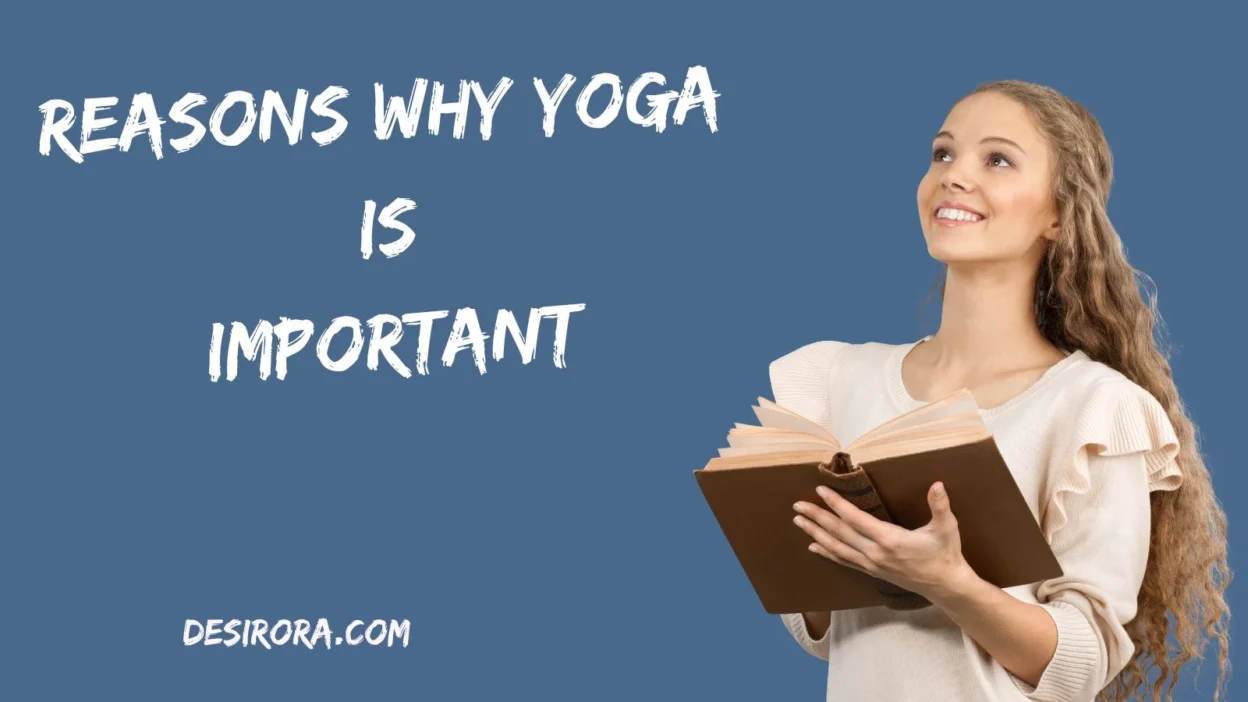Yoga isn’t just about stretching or striking perfect poses — it’s a way of life that connects your body, mind, and spirit. Originating thousands of years ago, yoga remains one of the most powerful practices for achieving balance in today’s fast-paced world. Whether you’re looking to improve your health, reduce stress, or find inner peace, yoga offers something for everyone.
From enhancing flexibility and strength to calming the mind and boosting focus, the benefits of yoga go far beyond the mat. It’s a practice that grows with you — nurturing your physical body, sharpening your mental clarity, and guiding you toward emotional stability.
In this article, we’ll explore the key reasons why yoga is important, how it impacts every area of life, and why millions around the world rely on it to feel centered, strong, and truly alive.
What You’ll Discover
- The many ways yoga supports body, mind, and spirit
- Real-life examples, idioms, and grammar tips to deepen your understanding
- A helpful synonym table and types of yoga to choose from
- How to make yoga work in your life, right now
Unearthing the Importance of Yoga
Yoga isn’t just another exercise trend. It’s a timeless practice rooted in thousands of years of wisdom — a union of body, mind, and breath. The word yoga comes from the Sanskrit root “yuj”, meaning “to unite” or “to join.”
Let’s explore why yoga is important — not only in theory but in real life.
Physical Benefits of Yoga
Improving strength, flexibility & balance
When you move into a pose and hold it — think of the tree pose or warrior sequence — you build strength, improve control, and find balance.
- Flexibility: Regular practice loosens tight muscles and connective tissue.
- Strength: Many yoga styles require supporting your body weight, creating functional power.
- Balance & joint health: As we age, balance becomes vital. Yoga helps reduce the risk of falls and joint stiffness.
“With a regular practice, your growth in flexibility, strength, focus, endurance, and willingness are exponential.”
Grammar Tip: The phrase “building muscles, improving control and balance” uses the present participle to show simultaneous actions — a smooth and active sentence structure.
Real-Life Example
Imagine sitting at a desk all day. Your hips tighten, and your back aches. After a few weeks of gentle yoga, you notice you can bend down easily and feel lighter in your body. That’s yoga working in real life.
Better posture, reduced pain
Poor posture — slouched shoulders, “tech neck” — is common. Yoga retrains your alignment and posture through awareness. It’s not about standing perfectly still but understanding how your body feels balanced and open.
Synonym table for “posture”
| Term | Meaning |
| Stance | The way you stand or position your body |
| Alignment | Correct positioning of body parts |
| Posture | The overall manner of holding one’s body |
| Bearing | The way you carry yourself |
Supporting cardiovascular & bone health
Yoga lowers blood pressure, boosts circulation, and supports heart health. It also strengthens bones because many poses are weight-bearing — like plank, downward dog, and warrior.
When you practice regularly, you strengthen muscles and protect your skeletal system, reducing the risk of osteoporosis.
Mental & Emotional Benefits
Stress relief & calming the nervous system
We live in a world of notifications, deadlines, and noise. Yoga helps quiet the chaos by activating the body’s “rest and digest” system. Through mindful breathing and slow movement, cortisol levels drop and calm returns.
Idiom in action
“You’re burning the candle at both ends.” We all do it sometimes. Yoga helps you pause, breathe, and find balance again.
Improving mood, mental clarity & sleep
A consistent yoga routine improves mood and clears mental fog. You feel grounded, less reactive, and more optimistic.
- Mental clarity: Yoga declutters the mind and improves focus.
- Sleep: Gentle poses or bedtime breathing sequences prepare you for deep, restful sleep.
- Mood boost: Endorphins, mindfulness, and body awareness combine to lift your emotional state.
Enhanced self-awareness & personal growth
Yoga is often called “a mirror.” It shows you how you move, think, and react. That awareness builds confidence and helps you grow emotionally.
You might notice that tension in your shoulders mirrors emotional stress — yoga helps you release both.
Social & Lifestyle Benefits
Community and connection
Joining a yoga class — in person or online — connects you with people who share similar goals. You learn, grow, and laugh together. The sense of belonging enriches your mental health and gives you motivation to keep going.
Encouraging healthy habits
Yoga naturally inspires better choices. Once you feel the benefits, you’ll likely eat more mindfully, drink more water, and prioritize rest. Yoga teaches awareness — and awareness changes everything.
Holistic wellbeing
Yoga blends physical movement, breathing, and mindfulness. It’s not just a workout — it’s a lifestyle philosophy that nurtures your whole self.
Types of Yoga: Choosing What Fits
Here’s a quick look at popular yoga styles:
| Type | Description |
| Hatha | Gentle, classic poses; great for beginners |
| Vinyasa | Flowing movements linked with breath; dynamic and energizing |
| Ashtanga | Structured, athletic, and challenging |
| Yin | Deep stretches held for long periods; great for flexibility and stillness |
| Restorative | Very gentle; uses props to promote relaxation |
| Chair or Gentle Yoga | Adapted for seniors or people with mobility issues |
Tip: If you have any health condition, check with a qualified teacher before starting.
Why Yoga Is Important: The Big Picture
Let’s break down the reasons clearly:
- Mind–body connection: Unites physical posture with inner awareness.
- Improved movement: Enhances flexibility, strength, and balance for daily life.
- Stress management: Teaches you to breathe through chaos.
- Mental clarity: Brings focus and calm.
- Healthy habits: Encourages mindfulness beyond the mat.
- Accessible for all: Age, body type, or fitness level — yoga meets you where you are.
- Longevity: Builds resilience, balance, and long-term wellness.
Yoga isn’t just a class; it’s a tool for a better life.
Real-Life Usage & Example Scenarios
- Morning routine: Ten minutes of sun salutations and deep breathing sets a peaceful tone for the day.
- Desk worker: A 20-minute stretch sequence after work melts away tension and stiffness.
- High-stress jobs: Practicing restorative yoga a few times a week leads to better sleep and focus.
- Seniors: Gentle yoga maintains mobility, balance, and confidence.
- Lifestyle change: Over time, yoga influences your food, mood, and mindset.
Grammar Focus: Active Voice vs Passive Voice
Yoga improves strength.
(Active voice — clear and direct.)
Strength is improved by yoga.
(Passive voice — less engaging.)
See the difference? Active voice draws readers in and makes your writing sound natural and confident.
Tips for Making Yoga a Meaningful Habit
- Start small: Even 10 minutes a few times a week makes a difference.
- Be consistent: Regular practice matters more than duration.
- Listen to your body: Yoga should feel challenging, not painful.
- Get guidance: A good instructor helps you avoid injury and improve form.
- Include breathing and mindfulness: Yoga isn’t complete without awareness.
- Use props: Blocks, straps, or pillows make poses more comfortable.
- Live yoga off the mat: Carry that calm energy into your everyday life.
A Word on Authenticity and Respect
Yoga originated in ancient India. Practicing it mindfully and respectfully adds depth to your experience. Understanding its roots helps you appreciate it as more than a workout — it’s a spiritual and philosophical path.
Summary Table: Key Benefits at a Glance
| Benefit Category | Examples of Impact |
| Physical | Strength, flexibility, posture, bone health |
| Mental/Emotional | Stress relief, better mood, improved sleep |
| Lifestyle | Mindful habits, reduced injury risk, better energy |
| Social | Community, belonging, motivation |
| Long-term Health | Longevity, balance, inner peace, emotional stability |
Conclusion
Yoga matters because it touches every part of who you are — your body, your breath, your thoughts, your heart. It’s a practice that grounds you when life feels chaotic, energizes you when you’re tired, and heals you when you feel out of sync.
It’s not about perfect poses or flexibility; it’s about connection.
Roll out your mat, take a deep breath, and start where you are — your future self will thank you.
FAQs
Q1: Can I start yoga if I’m not flexible?
Yes! Flexibility comes from yoga, not before it. Start gently, and your body will naturally open up with time.
Q2: How often should I practice?
Even 2-3 sessions per week can bring noticeable changes. The key is consistency, not intensity.
Q3: Is yoga enough exercise?
Yoga strengthens muscles, improves balance, and enhances flexibility. However, combining it with cardio or resistance training can create full-body fitness.
Q4: Which type of yoga is best for beginners?
Hatha or gentle vinyasa yoga are great starting points. They’re slower, more focused on basics, and beginner-friendly.
Q5: Can I do yoga if I have injuries?
Yes, but always consult your doctor and work with a certified instructor who can modify poses to keep you safe.

Aldous Huxley was a visionary writer and philosopher whose works explored human nature, consciousness, and the future of society. His ideas continue to challenge minds and inspire generations.



